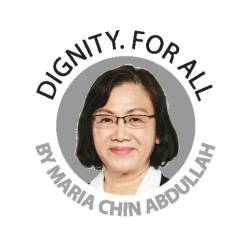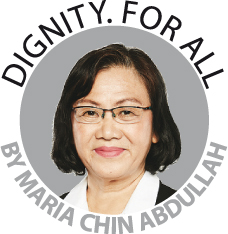PETALING JAYA has always been considered a well-developed, middle and upper middle-income district. The Department of Statistics in 2016 gave it a high average household income at RM7,904 a year. So, when Mak Ngah (not her real name) shared her story, I was taken aback.
“I have been staying in this area for 40 years, since 1977. My salary is RM700 per month which is just enough for basic needs. I can’t buy anything expensive. Nowadays RM50 is not enough to buy essentials from the shops. If we compare with 1977, definitely it is different. I have a daughter who is still schooling. I really don’t know what to do as she sometimes asks for money to buy school materials.”
Mak Ngah’s story rings true with the people of PJ, such as, the Khoos, Balas, Rosnahs and Marias, who are struggling to make ends meet. They make up the urban slum, mainly in Taman Medan and parts of Seri Setia, that have fallen in-between the cracks of prosperous Petaling Jaya. In Parliament, I have heard some MPs relating similar stories about pockets of poverty where the poor have been neglected due to uneven economic development, patronage and corruption. Faced with low incomes, any policies by the authorities to eliminate poverty will not be effective, without considering some form of social protection to help cover the costs of their basic necessities such as food, education, healthcare, housing, transport and others.
This year, the World Bank Economic Report on Malaysia was bleak, stating that economic growth forecast will drop from 5.4% to 4.9%. Other opinions like Allianz Group too confirmed an expected slower pace of 4.7% in 2018 from 5.9% in 2017. However, Deputy Minister of Trade and Industry Ong Kian Ming said that our manufacturing and services sectors, which make up 80% of our economy, is registering healthy growth.
So, what does this mean for the poor and vulnerable?
Unfortunately, the positive impact of economic growth is still not fully felt by Malaysians who need support and there is high expectation for government financial assistance to mitigate existing cost of living. The dependency is real. Yet, when their incomes are insufficient to pay for food, housing, and other essential needs, the poor tend to borrow and they fall into greater debt and deeper poverty.
The Pakatan government has introduced social safety net programmes and these are offered by various ministries. They include Bantuan Sara Hidup (Support for living cost); medical insurance with coverage of up to RM8,000; I-SURI with deductions from husbands’ Employees Provident Fund (EPF) being contributed towards their housewives’ future; food aid amounting to RM30 a household and other initiatives. A total of 200,000 units of affordable houses are offered, though the price of a unit even at as low as RM150,000 seems like a dream for many of the poor and vulnerable.
Despite these programmes, pockets of poverty still exist and Petaling Jaya is no exception where some residents are still struggling to make ends meet. In September 2018, a short survey was carried out of 46 children between the ages of seven months and 18 years living at the Lembah Subang People’s Housing Project in Seri Setia. It revealed that 80% of the children are underweight and suffer from stunted growth. The most likely cause is consumption of poor quality food, insufficient food intake, and poverty.
In Medan Cahaya at Taman Medan, 309 residents from three block of flats were surveyed. It was found that 48% of households fell into the B40 group (less than RM3,000). Most of them suffered from chronic illnesses with at least 14.8% of the respondents unable to afford any health insurance.
Malaysia must broaden and deepen its social protection system, or what is commonly called social safety net. Programmes such as cash and in-kind transfers can help to protect the poor and vulnerable households from the impact of economic shocks, natural disasters, and other crises.
At the end of the day, it is not only how much that is being spent or how many benefited from social protection initiatives but whether there is reduction in income inequality. Poverty levels have to be redefined to take into account liveable incomes that will pay for basic and essential goods and services. Other considerations include widening the category of beneficiaries to include the number of dependent children, persons with disabilities and elderly per household, geographical location of those who need assistance, and their accessibility to essential goods and services. Setting minimum wages is a step forward as this helps in income redistribution. However, fixing minimum wage at RM1,100 a month is hardly adequate assistance for the poor.
If we want to see a better standard of living, there must be monitoring and evaluation mechanisms to ensure temporary measures such as social safety nets are able to uplift the income of the poor. Resolving poverty demands an all-rounded approach where providing livable incomes has to be supported with institutional reforms for good education system, affordable healthcare facilities, housing and accessible transport system. The government policy vision in the mid-term review of the 11th Malaysia Plan, under its third pillar of “reforming governance towards greater transparency and enhancing efficiency of public service”, are good goals but they need to be implemented as soon as possible. From the vantage point of the poor and vulnerable, their expectations have not lowered. These policies must bring about an empower-ment approach that will facilitate a more equitable income distribution and promote the well-being for all in Malaysia.
Comments: letters@thesundaily.com














